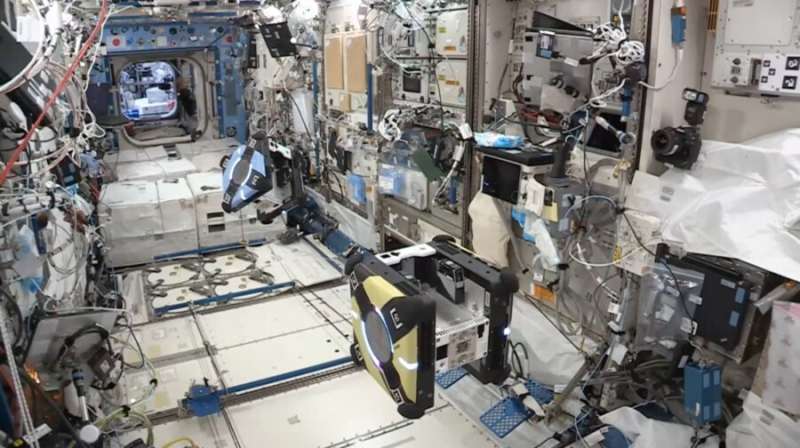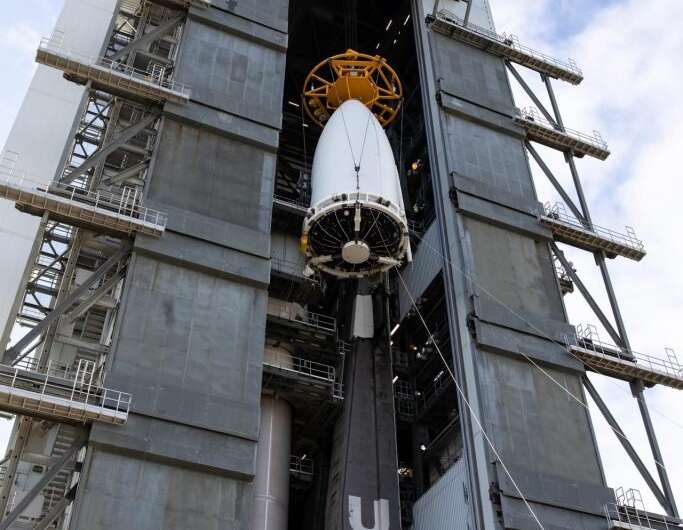
Copernical Team
NASA exploring ways to keep ISS afloat without Russian help: official

NASA is exploring ways to keep the International Space Station in orbit without Russian help, but doesn't see any immediate signs Moscow is withdrawing from the collaboration following the invasion of Ukraine, a senior official said Monday.
Kathy Lueders, who heads the agency's human spaceflight program, told reporters on a call that operations on the research platform were proceeding "nominally" and "we're not getting any indications at a working level that our counterparts are not committed.
ISS experiments to find solutions for cleaning up orbital debris and repairing damaged satellites

In 2002, the European Space Agency launched Envisat, the largest civilian satellite (at the time) to go to low Earth orbit (LEO).
ULA Atlas V rocket topped off with NOAA's GOES-T satellite

The National Oceanic and Atmospheric Administration's (NOAA) Geostationary Operational Environmental Satellite-T (GOES-T) satellite now officially has its ride.
GOES-T was transported from Astrotech's Space Operations facility in Titusville, Florida, to United Launch Alliance's (ULA) nearby Vertical Integration Facility at Cape Canaveral Space Force Station's Space Launch Complex 41. It was then mated to the top of the Atlas V 541 rocket, which will carry it into space.
ESA statement regarding cooperation with Russia following a meeting with Member States on 28 February 2022
Press Release N° 6–2022
We deplore the human casualties and tragic consequences of the war in Ukraine. We are giving absolute priority to taking proper decisions, not only for the sake of our workforce involved in the programmes, but in full respect of our European values, which have always fundamentally shaped our approach to international cooperation.
Keeping it fluid(ics) | Cosmic Kiss 360°
 Video:
00:02:58
Video:
00:02:58
Europe’s Columbus laboratory is a hive of activity in this 360° timelapse as ESA astronaut Matthias Maurer works on an experiment called Fluidics and his NASA colleague Raja Chari carries out activity in the Veggie plant habitat.
Developed by French space agency CNES and co-funded by Airbus, the Fluidics experiment investigates how liquids behave in space. It was first run by ESA astronaut Thomas Pesquet in 2017 during his Proxima mission.
Made up of six small, transparent spheres housed in the black centrifuge seen here, the experiment studies two phenomena. The first is ‘sloshing’ or how liquids move in
Tuning in to invisible waves on the JET tokamak
 Research scientist Alex Tinguely is readjusting to Cambridge and Boston. As a postdoc with the Plasma Science and Fusion Center (PSFC), the MIT graduate spent the last two years in Oxford, England, a city he recalls can be traversed entirely "in the time it takes to walk from MIT to Harvard."
With its ancient stone walls, cathedrals, cobblestone streets, and winding paths, that small city
Research scientist Alex Tinguely is readjusting to Cambridge and Boston. As a postdoc with the Plasma Science and Fusion Center (PSFC), the MIT graduate spent the last two years in Oxford, England, a city he recalls can be traversed entirely "in the time it takes to walk from MIT to Harvard."
With its ancient stone walls, cathedrals, cobblestone streets, and winding paths, that small city Satellite laser altimetry helps monitor changes in global lake water storage
 As the main freshwater resource on Earth's surface, lakes play an important role in maintaining ecosystem stability and the sustainable development of human society.
However, it's been difficult to evaluate changes in global lake-water volume across space and time due to data problems. Specifically, ground-monitoring data have not been sufficiently representative of all lakes, and traditio
As the main freshwater resource on Earth's surface, lakes play an important role in maintaining ecosystem stability and the sustainable development of human society.
However, it's been difficult to evaluate changes in global lake-water volume across space and time due to data problems. Specifically, ground-monitoring data have not been sufficiently representative of all lakes, and traditio NASA develops technology to dissect the lower atmosphere
 The part of the atmosphere closest to the planet is the hardest to measure from space due to the volume of gases above it. Studying Earth's planetary boundary layer, or PBL, will enable scientists to better understand the interaction between Earth's surface and weather and how that evolves in a global, changing climate.
"The planetary boundary layer is where we live and where we experience
The part of the atmosphere closest to the planet is the hardest to measure from space due to the volume of gases above it. Studying Earth's planetary boundary layer, or PBL, will enable scientists to better understand the interaction between Earth's surface and weather and how that evolves in a global, changing climate.
"The planetary boundary layer is where we live and where we experience NASA supports research to advance earth science
 Through a new prize competition, NASA is engaging minority serving institutions (MSIs) to bring ideas for new information technologies that will help address climate change. The prize competition, the MSI Space Accelerator, comes from a new partnership between NASA's Science Mission Directorate, the Minority University Research Education Project within the Office of STEM Engagement, NASA's Jet P
Through a new prize competition, NASA is engaging minority serving institutions (MSIs) to bring ideas for new information technologies that will help address climate change. The prize competition, the MSI Space Accelerator, comes from a new partnership between NASA's Science Mission Directorate, the Minority University Research Education Project within the Office of STEM Engagement, NASA's Jet P Advanced Air Mobility for Healthcare
 During the global pandemic people have realized remote healthcare, delivery, and easy access to services are paramount. NASA's Advanced Air Mobility or AAM mission paves the way toward enabling significant air mobility needs such as better access to healthcare services.
AAM has the potential to provide medical transport for people and supplies around the world. This could be a highly autom
During the global pandemic people have realized remote healthcare, delivery, and easy access to services are paramount. NASA's Advanced Air Mobility or AAM mission paves the way toward enabling significant air mobility needs such as better access to healthcare services.
AAM has the potential to provide medical transport for people and supplies around the world. This could be a highly autom 
